Analyzing Consumer Behavior, Brand Equity, and Marketing Strategies
VerifiedAdded on 2023/06/05
|6
|1766
|122
Report
AI Summary
This report delves into various aspects of marketing and management, beginning with an examination of how a consumer's level of involvement influences their problem-solving process, illustrated with examples of organizational need triggers and post-purchase cognitive dissonance. It identifies targeting strategies employed by companies like Mazda and Shoes of Prey, highlighting their approaches to reaching specific demographics. The report further analyzes how Kate Spade utilizes its website to connect with customers through scholarships, career opportunities, and engaging designs. It argues that companies aiming for sustainable brand development gain a competitive edge by focusing on long-term value and customer needs, citing examples like IKEA and Unilever. Finally, it discusses pricing policies for innovative product launches, particularly penetration pricing, and its implications for market share and profitability, referencing companies like Dell and their strategies for market entry.
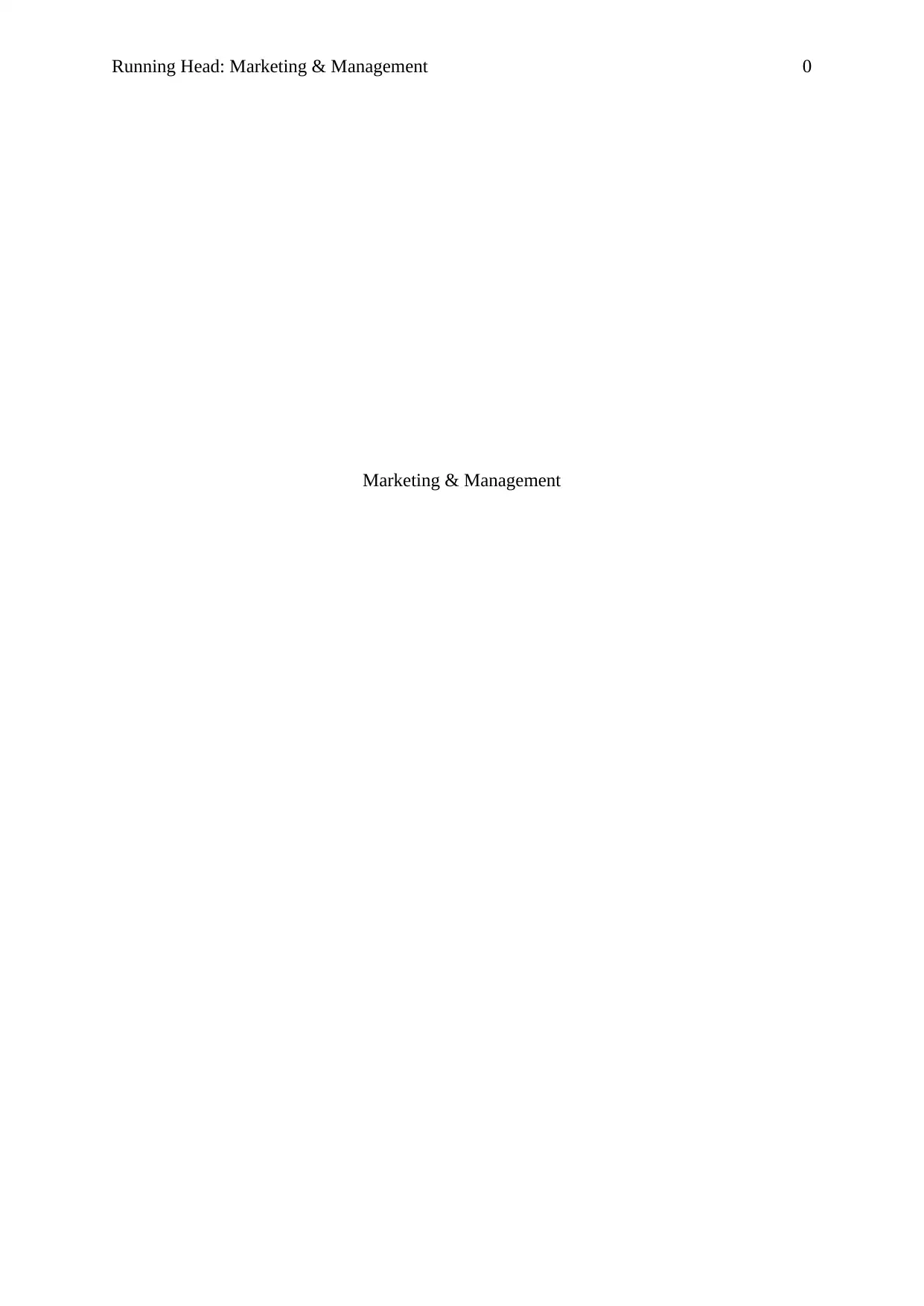
Running Head: Marketing & Management 0
Marketing & Management
Marketing & Management
Paraphrase This Document
Need a fresh take? Get an instant paraphrase of this document with our AI Paraphraser
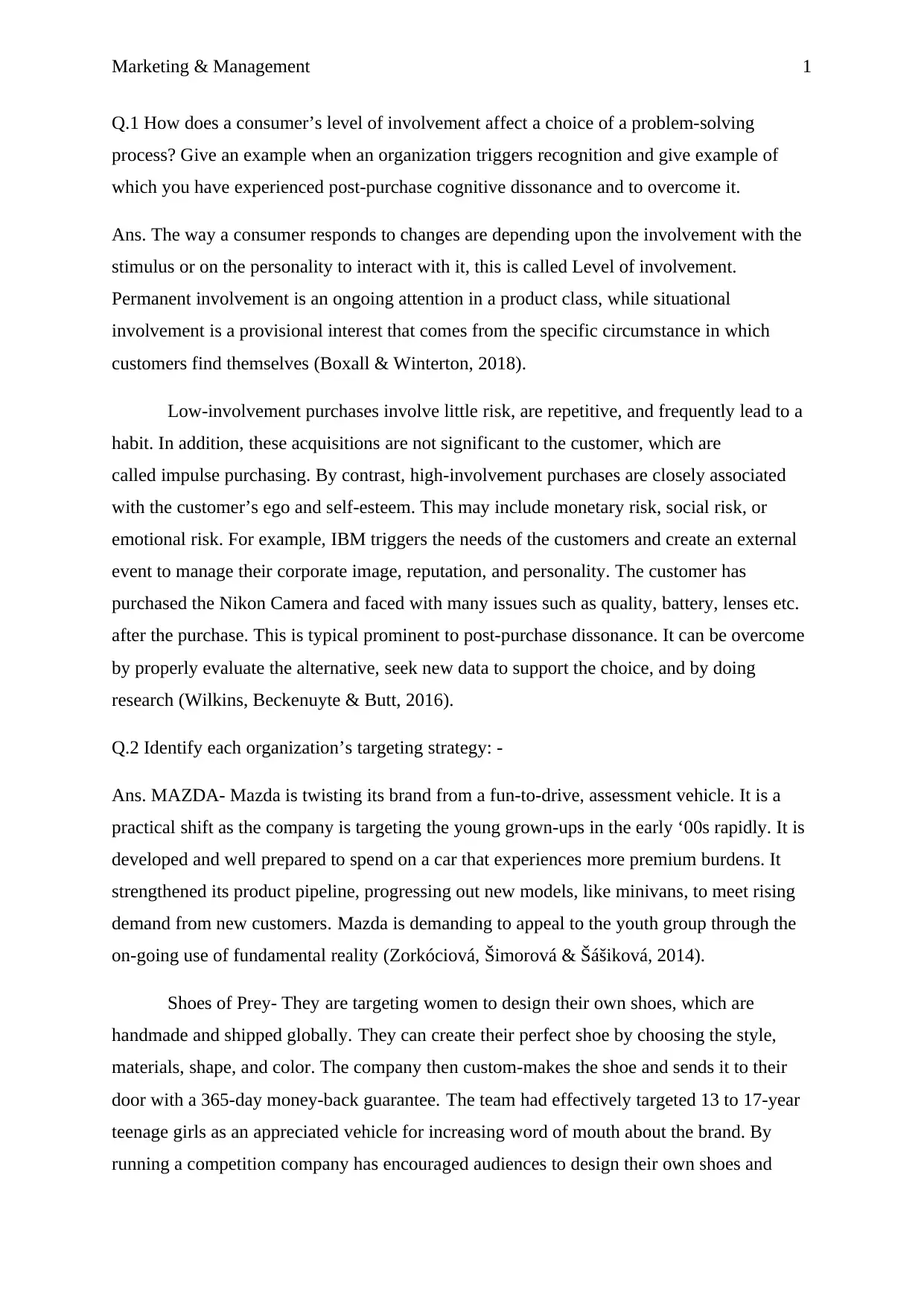
Marketing & Management 1
Q.1 How does a consumer’s level of involvement affect a choice of a problem-solving
process? Give an example when an organization triggers recognition and give example of
which you have experienced post-purchase cognitive dissonance and to overcome it.
Ans. The way a consumer responds to changes are depending upon the involvement with the
stimulus or on the personality to interact with it, this is called Level of involvement.
Permanent involvement is an ongoing attention in a product class, while situational
involvement is a provisional interest that comes from the specific circumstance in which
customers find themselves (Boxall & Winterton, 2018).
Low-involvement purchases involve little risk, are repetitive, and frequently lead to a
habit. In addition, these acquisitions are not significant to the customer, which are
called impulse purchasing. By contrast, high-involvement purchases are closely associated
with the customer’s ego and self-esteem. This may include monetary risk, social risk, or
emotional risk. For example, IBM triggers the needs of the customers and create an external
event to manage their corporate image, reputation, and personality. The customer has
purchased the Nikon Camera and faced with many issues such as quality, battery, lenses etc.
after the purchase. This is typical prominent to post-purchase dissonance. It can be overcome
by properly evaluate the alternative, seek new data to support the choice, and by doing
research (Wilkins, Beckenuyte & Butt, 2016).
Q.2 Identify each organization’s targeting strategy: -
Ans. MAZDA- Mazda is twisting its brand from a fun-to-drive, assessment vehicle. It is a
practical shift as the company is targeting the young grown-ups in the early ‘00s rapidly. It is
developed and well prepared to spend on a car that experiences more premium burdens. It
strengthened its product pipeline, progressing out new models, like minivans, to meet rising
demand from new customers. Mazda is demanding to appeal to the youth group through the
on-going use of fundamental reality (Zorkóciová, Šimorová & Šášiková, 2014).
Shoes of Prey- They are targeting women to design their own shoes, which are
handmade and shipped globally. They can create their perfect shoe by choosing the style,
materials, shape, and color. The company then custom-makes the shoe and sends it to their
door with a 365-day money-back guarantee. The team had effectively targeted 13 to 17-year
teenage girls as an appreciated vehicle for increasing word of mouth about the brand. By
running a competition company has encouraged audiences to design their own shoes and
Q.1 How does a consumer’s level of involvement affect a choice of a problem-solving
process? Give an example when an organization triggers recognition and give example of
which you have experienced post-purchase cognitive dissonance and to overcome it.
Ans. The way a consumer responds to changes are depending upon the involvement with the
stimulus or on the personality to interact with it, this is called Level of involvement.
Permanent involvement is an ongoing attention in a product class, while situational
involvement is a provisional interest that comes from the specific circumstance in which
customers find themselves (Boxall & Winterton, 2018).
Low-involvement purchases involve little risk, are repetitive, and frequently lead to a
habit. In addition, these acquisitions are not significant to the customer, which are
called impulse purchasing. By contrast, high-involvement purchases are closely associated
with the customer’s ego and self-esteem. This may include monetary risk, social risk, or
emotional risk. For example, IBM triggers the needs of the customers and create an external
event to manage their corporate image, reputation, and personality. The customer has
purchased the Nikon Camera and faced with many issues such as quality, battery, lenses etc.
after the purchase. This is typical prominent to post-purchase dissonance. It can be overcome
by properly evaluate the alternative, seek new data to support the choice, and by doing
research (Wilkins, Beckenuyte & Butt, 2016).
Q.2 Identify each organization’s targeting strategy: -
Ans. MAZDA- Mazda is twisting its brand from a fun-to-drive, assessment vehicle. It is a
practical shift as the company is targeting the young grown-ups in the early ‘00s rapidly. It is
developed and well prepared to spend on a car that experiences more premium burdens. It
strengthened its product pipeline, progressing out new models, like minivans, to meet rising
demand from new customers. Mazda is demanding to appeal to the youth group through the
on-going use of fundamental reality (Zorkóciová, Šimorová & Šášiková, 2014).
Shoes of Prey- They are targeting women to design their own shoes, which are
handmade and shipped globally. They can create their perfect shoe by choosing the style,
materials, shape, and color. The company then custom-makes the shoe and sends it to their
door with a 365-day money-back guarantee. The team had effectively targeted 13 to 17-year
teenage girls as an appreciated vehicle for increasing word of mouth about the brand. By
running a competition company has encouraged audiences to design their own shoes and
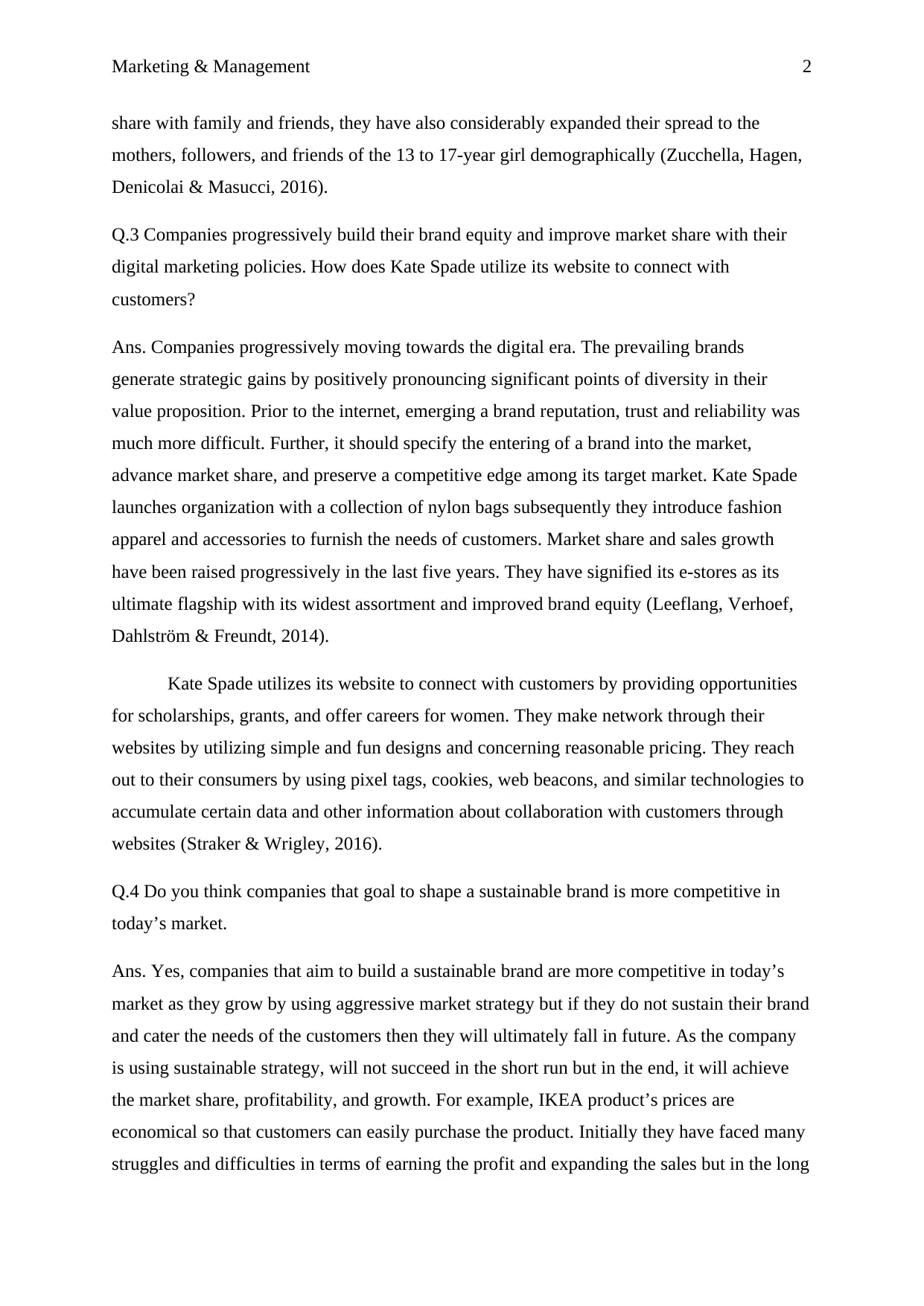
Marketing & Management 2
share with family and friends, they have also considerably expanded their spread to the
mothers, followers, and friends of the 13 to 17-year girl demographically (Zucchella, Hagen,
Denicolai & Masucci, 2016).
Q.3 Companies progressively build their brand equity and improve market share with their
digital marketing policies. How does Kate Spade utilize its website to connect with
customers?
Ans. Companies progressively moving towards the digital era. The prevailing brands
generate strategic gains by positively pronouncing significant points of diversity in their
value proposition. Prior to the internet, emerging a brand reputation, trust and reliability was
much more difficult. Further, it should specify the entering of a brand into the market,
advance market share, and preserve a competitive edge among its target market. Kate Spade
launches organization with a collection of nylon bags subsequently they introduce fashion
apparel and accessories to furnish the needs of customers. Market share and sales growth
have been raised progressively in the last five years. They have signified its e-stores as its
ultimate flagship with its widest assortment and improved brand equity (Leeflang, Verhoef,
Dahlström & Freundt, 2014).
Kate Spade utilizes its website to connect with customers by providing opportunities
for scholarships, grants, and offer careers for women. They make network through their
websites by utilizing simple and fun designs and concerning reasonable pricing. They reach
out to their consumers by using pixel tags, cookies, web beacons, and similar technologies to
accumulate certain data and other information about collaboration with customers through
websites (Straker & Wrigley, 2016).
Q.4 Do you think companies that goal to shape a sustainable brand is more competitive in
today’s market.
Ans. Yes, companies that aim to build a sustainable brand are more competitive in today’s
market as they grow by using aggressive market strategy but if they do not sustain their brand
and cater the needs of the customers then they will ultimately fall in future. As the company
is using sustainable strategy, will not succeed in the short run but in the end, it will achieve
the market share, profitability, and growth. For example, IKEA product’s prices are
economical so that customers can easily purchase the product. Initially they have faced many
struggles and difficulties in terms of earning the profit and expanding the sales but in the long
share with family and friends, they have also considerably expanded their spread to the
mothers, followers, and friends of the 13 to 17-year girl demographically (Zucchella, Hagen,
Denicolai & Masucci, 2016).
Q.3 Companies progressively build their brand equity and improve market share with their
digital marketing policies. How does Kate Spade utilize its website to connect with
customers?
Ans. Companies progressively moving towards the digital era. The prevailing brands
generate strategic gains by positively pronouncing significant points of diversity in their
value proposition. Prior to the internet, emerging a brand reputation, trust and reliability was
much more difficult. Further, it should specify the entering of a brand into the market,
advance market share, and preserve a competitive edge among its target market. Kate Spade
launches organization with a collection of nylon bags subsequently they introduce fashion
apparel and accessories to furnish the needs of customers. Market share and sales growth
have been raised progressively in the last five years. They have signified its e-stores as its
ultimate flagship with its widest assortment and improved brand equity (Leeflang, Verhoef,
Dahlström & Freundt, 2014).
Kate Spade utilizes its website to connect with customers by providing opportunities
for scholarships, grants, and offer careers for women. They make network through their
websites by utilizing simple and fun designs and concerning reasonable pricing. They reach
out to their consumers by using pixel tags, cookies, web beacons, and similar technologies to
accumulate certain data and other information about collaboration with customers through
websites (Straker & Wrigley, 2016).
Q.4 Do you think companies that goal to shape a sustainable brand is more competitive in
today’s market.
Ans. Yes, companies that aim to build a sustainable brand are more competitive in today’s
market as they grow by using aggressive market strategy but if they do not sustain their brand
and cater the needs of the customers then they will ultimately fall in future. As the company
is using sustainable strategy, will not succeed in the short run but in the end, it will achieve
the market share, profitability, and growth. For example, IKEA product’s prices are
economical so that customers can easily purchase the product. Initially they have faced many
struggles and difficulties in terms of earning the profit and expanding the sales but in the long
⊘ This is a preview!⊘
Do you want full access?
Subscribe today to unlock all pages.

Trusted by 1+ million students worldwide
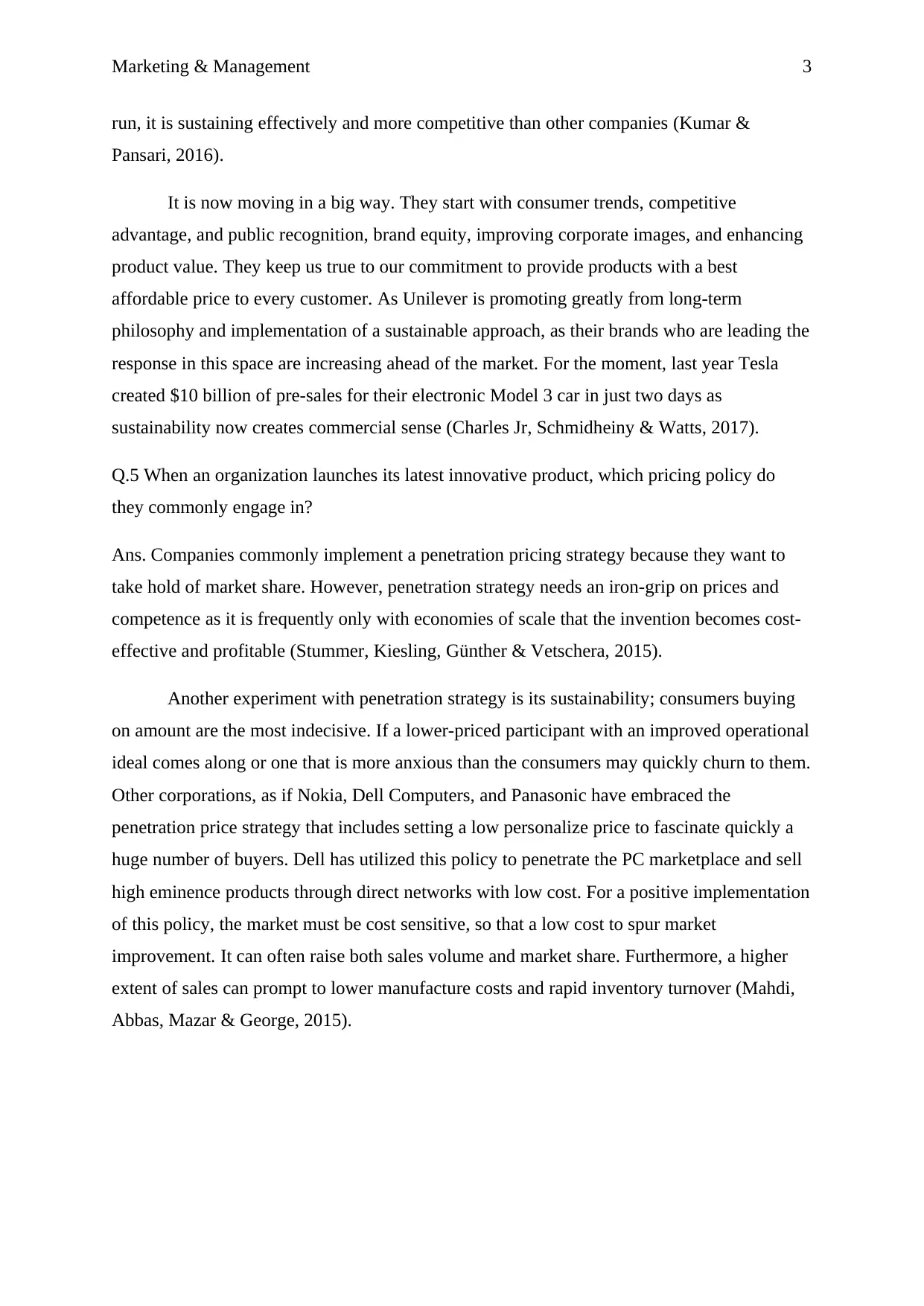
Marketing & Management 3
run, it is sustaining effectively and more competitive than other companies (Kumar &
Pansari, 2016).
It is now moving in a big way. They start with consumer trends, competitive
advantage, and public recognition, brand equity, improving corporate images, and enhancing
product value. They keep us true to our commitment to provide products with a best
affordable price to every customer. As Unilever is promoting greatly from long-term
philosophy and implementation of a sustainable approach, as their brands who are leading the
response in this space are increasing ahead of the market. For the moment, last year Tesla
created $10 billion of pre-sales for their electronic Model 3 car in just two days as
sustainability now creates commercial sense (Charles Jr, Schmidheiny & Watts, 2017).
Q.5 When an organization launches its latest innovative product, which pricing policy do
they commonly engage in?
Ans. Companies commonly implement a penetration pricing strategy because they want to
take hold of market share. However, penetration strategy needs an iron-grip on prices and
competence as it is frequently only with economies of scale that the invention becomes cost-
effective and profitable (Stummer, Kiesling, Günther & Vetschera, 2015).
Another experiment with penetration strategy is its sustainability; consumers buying
on amount are the most indecisive. If a lower-priced participant with an improved operational
ideal comes along or one that is more anxious than the consumers may quickly churn to them.
Other corporations, as if Nokia, Dell Computers, and Panasonic have embraced the
penetration price strategy that includes setting a low personalize price to fascinate quickly a
huge number of buyers. Dell has utilized this policy to penetrate the PC marketplace and sell
high eminence products through direct networks with low cost. For a positive implementation
of this policy, the market must be cost sensitive, so that a low cost to spur market
improvement. It can often raise both sales volume and market share. Furthermore, a higher
extent of sales can prompt to lower manufacture costs and rapid inventory turnover (Mahdi,
Abbas, Mazar & George, 2015).
run, it is sustaining effectively and more competitive than other companies (Kumar &
Pansari, 2016).
It is now moving in a big way. They start with consumer trends, competitive
advantage, and public recognition, brand equity, improving corporate images, and enhancing
product value. They keep us true to our commitment to provide products with a best
affordable price to every customer. As Unilever is promoting greatly from long-term
philosophy and implementation of a sustainable approach, as their brands who are leading the
response in this space are increasing ahead of the market. For the moment, last year Tesla
created $10 billion of pre-sales for their electronic Model 3 car in just two days as
sustainability now creates commercial sense (Charles Jr, Schmidheiny & Watts, 2017).
Q.5 When an organization launches its latest innovative product, which pricing policy do
they commonly engage in?
Ans. Companies commonly implement a penetration pricing strategy because they want to
take hold of market share. However, penetration strategy needs an iron-grip on prices and
competence as it is frequently only with economies of scale that the invention becomes cost-
effective and profitable (Stummer, Kiesling, Günther & Vetschera, 2015).
Another experiment with penetration strategy is its sustainability; consumers buying
on amount are the most indecisive. If a lower-priced participant with an improved operational
ideal comes along or one that is more anxious than the consumers may quickly churn to them.
Other corporations, as if Nokia, Dell Computers, and Panasonic have embraced the
penetration price strategy that includes setting a low personalize price to fascinate quickly a
huge number of buyers. Dell has utilized this policy to penetrate the PC marketplace and sell
high eminence products through direct networks with low cost. For a positive implementation
of this policy, the market must be cost sensitive, so that a low cost to spur market
improvement. It can often raise both sales volume and market share. Furthermore, a higher
extent of sales can prompt to lower manufacture costs and rapid inventory turnover (Mahdi,
Abbas, Mazar & George, 2015).
Paraphrase This Document
Need a fresh take? Get an instant paraphrase of this document with our AI Paraphraser
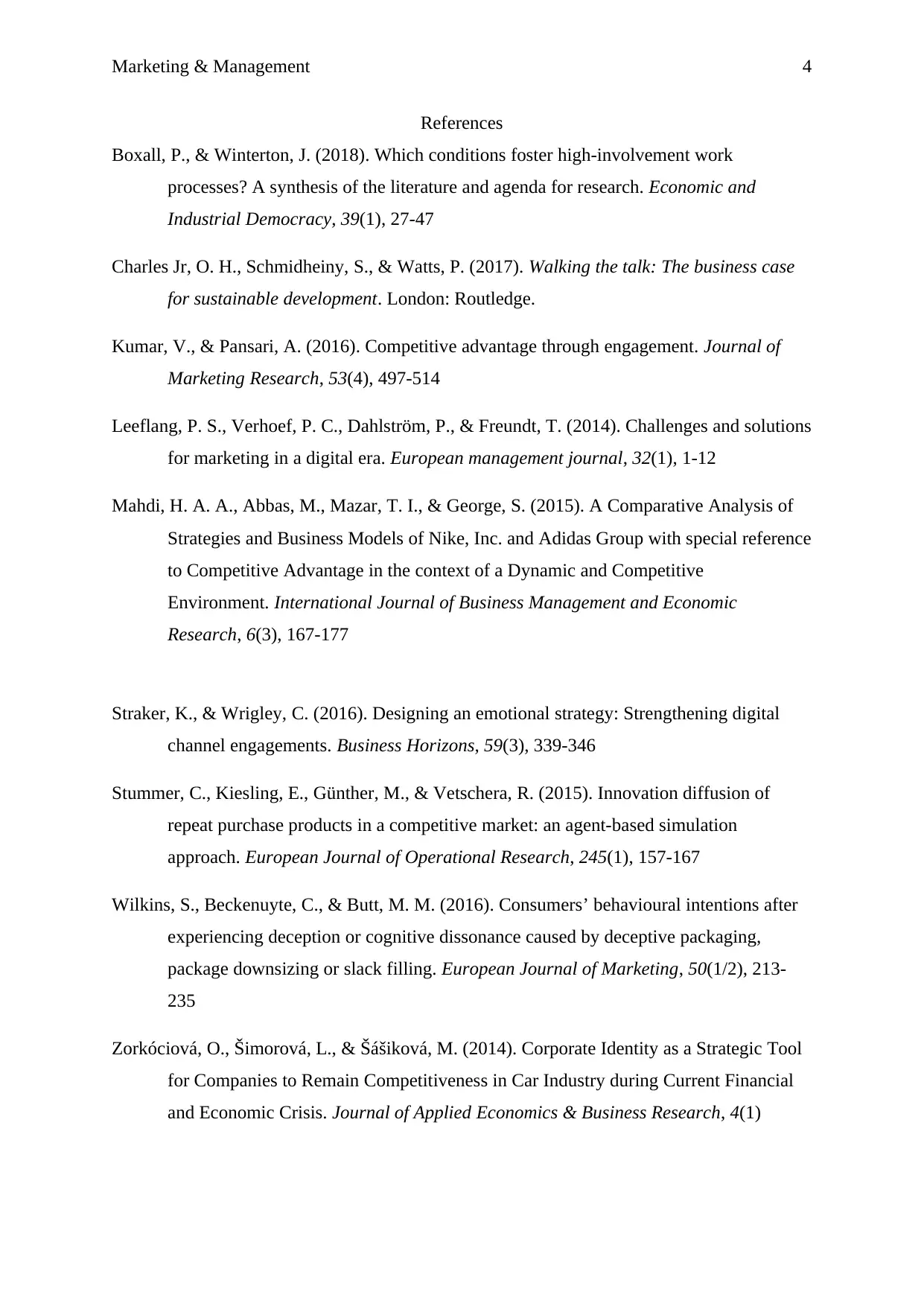
Marketing & Management 4
References
Boxall, P., & Winterton, J. (2018). Which conditions foster high-involvement work
processes? A synthesis of the literature and agenda for research. Economic and
Industrial Democracy, 39(1), 27-47
Charles Jr, O. H., Schmidheiny, S., & Watts, P. (2017). Walking the talk: The business case
for sustainable development. London: Routledge.
Kumar, V., & Pansari, A. (2016). Competitive advantage through engagement. Journal of
Marketing Research, 53(4), 497-514
Leeflang, P. S., Verhoef, P. C., Dahlström, P., & Freundt, T. (2014). Challenges and solutions
for marketing in a digital era. European management journal, 32(1), 1-12
Mahdi, H. A. A., Abbas, M., Mazar, T. I., & George, S. (2015). A Comparative Analysis of
Strategies and Business Models of Nike, Inc. and Adidas Group with special reference
to Competitive Advantage in the context of a Dynamic and Competitive
Environment. International Journal of Business Management and Economic
Research, 6(3), 167-177
Straker, K., & Wrigley, C. (2016). Designing an emotional strategy: Strengthening digital
channel engagements. Business Horizons, 59(3), 339-346
Stummer, C., Kiesling, E., Günther, M., & Vetschera, R. (2015). Innovation diffusion of
repeat purchase products in a competitive market: an agent-based simulation
approach. European Journal of Operational Research, 245(1), 157-167
Wilkins, S., Beckenuyte, C., & Butt, M. M. (2016). Consumers’ behavioural intentions after
experiencing deception or cognitive dissonance caused by deceptive packaging,
package downsizing or slack filling. European Journal of Marketing, 50(1/2), 213-
235
Zorkóciová, O., Šimorová, L., & Šášiková, M. (2014). Corporate Identity as a Strategic Tool
for Companies to Remain Competitiveness in Car Industry during Current Financial
and Economic Crisis. Journal of Applied Economics & Business Research, 4(1)
References
Boxall, P., & Winterton, J. (2018). Which conditions foster high-involvement work
processes? A synthesis of the literature and agenda for research. Economic and
Industrial Democracy, 39(1), 27-47
Charles Jr, O. H., Schmidheiny, S., & Watts, P. (2017). Walking the talk: The business case
for sustainable development. London: Routledge.
Kumar, V., & Pansari, A. (2016). Competitive advantage through engagement. Journal of
Marketing Research, 53(4), 497-514
Leeflang, P. S., Verhoef, P. C., Dahlström, P., & Freundt, T. (2014). Challenges and solutions
for marketing in a digital era. European management journal, 32(1), 1-12
Mahdi, H. A. A., Abbas, M., Mazar, T. I., & George, S. (2015). A Comparative Analysis of
Strategies and Business Models of Nike, Inc. and Adidas Group with special reference
to Competitive Advantage in the context of a Dynamic and Competitive
Environment. International Journal of Business Management and Economic
Research, 6(3), 167-177
Straker, K., & Wrigley, C. (2016). Designing an emotional strategy: Strengthening digital
channel engagements. Business Horizons, 59(3), 339-346
Stummer, C., Kiesling, E., Günther, M., & Vetschera, R. (2015). Innovation diffusion of
repeat purchase products in a competitive market: an agent-based simulation
approach. European Journal of Operational Research, 245(1), 157-167
Wilkins, S., Beckenuyte, C., & Butt, M. M. (2016). Consumers’ behavioural intentions after
experiencing deception or cognitive dissonance caused by deceptive packaging,
package downsizing or slack filling. European Journal of Marketing, 50(1/2), 213-
235
Zorkóciová, O., Šimorová, L., & Šášiková, M. (2014). Corporate Identity as a Strategic Tool
for Companies to Remain Competitiveness in Car Industry during Current Financial
and Economic Crisis. Journal of Applied Economics & Business Research, 4(1)

Marketing & Management 5
Zucchella, A., Hagen, B., Denicolai, S., & Masucci, M. (2016). Early and accelerated
internationalisation: the role of the niche strategy in a new generation of
exporters. International Journal of Export Marketing, 1(1), 27-47
Zucchella, A., Hagen, B., Denicolai, S., & Masucci, M. (2016). Early and accelerated
internationalisation: the role of the niche strategy in a new generation of
exporters. International Journal of Export Marketing, 1(1), 27-47
⊘ This is a preview!⊘
Do you want full access?
Subscribe today to unlock all pages.

Trusted by 1+ million students worldwide
1 out of 6
Your All-in-One AI-Powered Toolkit for Academic Success.
+13062052269
info@desklib.com
Available 24*7 on WhatsApp / Email
![[object Object]](/_next/static/media/star-bottom.7253800d.svg)
Unlock your academic potential
Copyright © 2020–2025 A2Z Services. All Rights Reserved. Developed and managed by ZUCOL.

